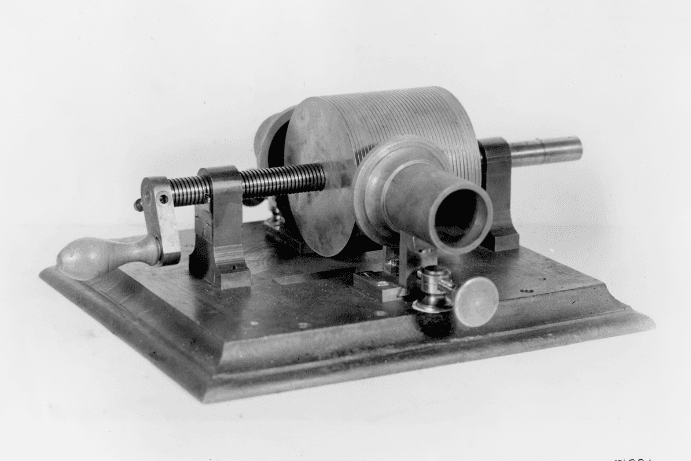Imagine a world without music streaming, podcasts, or even recorded speeches. A world where every song, every voice, and every performance existed only in the moment when it was created and lost after that. Hard to picture, right? But that was reality until one groundbreaking invention changed everything—Thomas Edison’s phonograph.
Let’s travel back in time to February 19. 1878. The moment when Edison’s curiosity and relentless innovation received the patent for the first practical sound recording device, the Phonograph. A device that would not only preserve sound but transform how we experience it forever.
The Accidental Birth of Sound Recording
It all started in the late 19th century, an era when invention was booming. Edison was already famous for his work on the telegraph and telephone.
In 1877, while working on a device that could transcribe telegraph signals onto paper, he had a wild thought: What if sound waves could be captured and played back?
There started the magic of sound recording! For the first time in history, sound had been recorded and reproduced.
Thomas Edison made that unimaginable future a reality and mesmerized the world by introducing the phonograph. He received the patent for phonograph on February 19, 1878, with Patent No. 200,521.
This wasn’t just a technical milestone; it was a cultural revolt. It was the sunrise of an entirely new way for humans to document and share experiences. The phonograph paved the way for the music industry, broadcast media, and even the preservation of historical speeches.
Edison created the first working phonograph using a tin-foil-wrapped cylinder, a stylus, and a hand-cranked mechanism.
The first recorded words are, “Mary had a little lamb.” That simple nursery rhyme, captured and replayed, stunned Edison and his team.
Edison’s Phonograph: A Marvel of Its Time
Edison’s original phonograph worked on a surprisingly simple principle:
- Sound waves were captured through a mouthpiece.
- A diaphragm and stylus translated those waves into physical indentations onto a rotating cylinder covered in tin foil.
- To play it back, the stylus retraced the indentations, vibrating to recreate the recorded sound.
While primitive by today’s standards, this invention was revolutionary. People could now listen to something recorded in the past, a concept unheard of before.
But there was one big problem—the tin foil recordings were fragile and wore out quickly. To make sound recording truly practical, further innovation was needed.
The Evolution: From Tin Foil to Wax and Beyond
Edison, being Edison, didn’t stop at just inventing the phonograph. Over the next decade, he and his competitors refined the technology.
- In the 1880s, wax cylinders replaced tin foil, making recordings more durable and clearer.
- By the 1890s, commercial phonograph machines and pre-recorded music became available to the public.
- In the early 20th century, flat disc records emerged, ultimately leading to the vinyl records that dominated the music industry for decades.
Edison, however, had his own vision for the phonograph. He believed its true potential lay in business dictation, education, and archival purposes rather than entertainment.
While this limited his direct success in the music industry, his technological foundation paved the way for the recording revolution that followed.
The Cultural Impact: A New Way to Preserve History
Edison’s invention didn’t just change the music industry—it changed how humanity preserved its past. For the first time, people could hear the voices of world leaders, musicians, and everyday individuals long after they were gone.
- Speeches by historical figures like Theodore Roosevelt and Woodrow Wilson were recorded for posterity.
- Classical musicians and opera singers, once only accessible in concert halls, could now reach people worldwide.
Without Edison’s phonograph, there would be no record players, no cassette tapes, no CDs, not even digital streaming. It all traces back to that first moment in 1877 when a nursery rhyme echoed back from a tin foil cylinder.
On February 19, We Celebrate a Sound Revolution
Every time we press “play” on our favorite song or listen to a podcast, we owe a nod to Thomas Edison. His phonograph was the first step in a long journey that has brought us everything from vinyl records to Spotify.
So, on this day, take a moment to celebrate the incredible invention of sound recording. From Edison’s laboratory to the digital age, the phonograph has shaped the way we connect, entertain, and remember.
And to celebrate the history—it all started with “Mary had a little lamb.”

